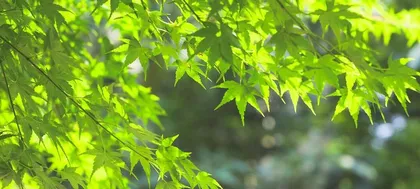Maple trees are common landscape trees in our country, but the maple leaf-rolling disease is a headache for many. How to deal with maple leaf-rolling and protect maple trees has become an important task. This article will introduce methods and measures to deal with maple leaf-rolling.

I: Understanding Maple Leaf-Rolling
Maple leaf-rolling is a common disease caused by the larvae of the leaf-rolling moth, which mainly affects plants such as maple and elm trees. The larvae build pupal chambers on the tree, and after a period of time, the adult moths emerge. This disease can cause maple leaves to curl and fall off, posing a threat to the tree's growth.
II: Strengthening Maple Tree Management
Timely removal of fallen leaves, snow dust, and garbage from the tree, cleaning the trunk and bark, and maintaining the tree's ventilation and light penetration. Regular fertilization and watering can increase the nutrition of the maple tree, which is conducive to its healthy growth and improves its ability to resist diseases.

III: Spraying Insecticides
Use low-toxicity and environmentally friendly insecticides, with the main method of killing insects to control the occurrence of the disease. Regular spraying of insecticides can effectively prevent and control maple leaf-rolling, avoid larval invasion, and keep the maple tree healthy.
IV: Increasing Garden Diversity
The diversity of plants can help resist the occurrence of diseases. Increasing the variety of vegetation in the garden can reduce the damage from insects and pathogens to maple trees and decrease the incidence of diseases.
V: Regular Pruning of Branches and Leaves
Regularly prune the branches and leaves of the maple tree to make its shape more beautiful and also reduce the chance of disease. Timely removal of withered, aged, diseased, and pest-infested leaves and branches can reduce the burden on the maple tree.

VI: Strengthening Irrigation Management
Maple trees need an appropriate amount of water to maintain their healthy growth. Strengthening irrigation management and providing sufficient water for the maple tree is beneficial for improving its disease resistance.
VII: Enhancing Light Exposure
Maple trees have high requirements for light. Appropriately increasing the light exposure for the maple tree can improve its disease resistance and growth rate. At the same time, attention should be paid to sun protection to avoid excessive sun exposure, which can damage the maple tree.
VIII: Timely Detection of Diseases
Regularly inspect the maple tree, and treat diseases such as leaf-rolling in a timely manner to prevent the spread of the disease, effectively control its occurrence, and maintain the healthy growth of the maple tree.
IX: Removing Larvae
If larvae of the leaf-rolling moth are found to be breeding on the maple tree, they should be removed promptly to prevent them from continuing to damage the leaves and branches of the maple tree and ensure its normal growth.
X: Enhancing Soil Fertility
Properly adjusting the pH and nutrient content of the soil to make it fertile and rich in organic matter is beneficial for promoting the growth and health of the maple tree. Soil fertility can be enhanced through methods such as fertilization, mulching with biomass, and planting green manure.
XI: Preventing Cross-Infection
Maple leaf-rolling is a contagious disease, so it is necessary to prevent cross-infection. When pruning, watering, or other operations on the maple tree, use clean tools and water sources to avoid spreading pathogens to other plants.
XII: Strengthening Pest and Disease Monitoring
Strengthen the monitoring of pests and diseases to promptly understand the occurrence of maple leaf-rolling and other pests and diseases, and make timely disposal and control to protect the health of the maple tree.
XIII: Cultivating a Good Environment
A good ecological environment is beneficial for protecting the health of maple trees and other plants and reducing the occurrence of pests and diseases. Pay attention to maintaining environmental hygiene, reducing pollution from garbage and pollutants, and creating a good environment suitable for plant growth.
XIV: Strengthening Science Popularization and Publicity
Carry out science popularization and publicity for common pests and diseases such as maple leaf-rolling to let the public understand their hazards and prevention methods, improve everyone's greening awareness, and jointly protect the environment and ecology.
XV:
Maple leaf-rolling disease is one of the common pests and diseases. Adopting comprehensive measures to strengthen maple tree management and control the occurrence of the disease, protecting maple trees has become our common responsibility. By strengthening science popularization and publicity, improving public greening awareness, we can jointly protect our green homes.